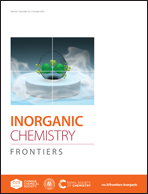Axial functionalisation of photoactive diazido platinum(iv) anticancer complexes†
Abstract
Mono-axial functionalised octahedral diazido Pt(IV) complexes trans,trans,trans-[Pt(py)2(N3)2(OR1)(OR2)] (OR1 = OH and OR2 = anticancer agent coumarin-3 carboxylate (cou, 2a), pyruvate dehydrogenase kinase (PDK) inhibitors 4-phenylbutyrate (PhB, 2b) or dichloroacetate (DCA, 2c)), and their di-axial functionalised analogues with OR1 = DCA and OR2 = cou (3a), PhB (3b), or DCA (3c) have been synthesised and characterised, including the X-ray crystal structures of complexes 2a, 3a, 3b and 3c. These complexes exhibit dark stability and have the potential to generate cytotoxic Pt(II) species and free radicals selectively in cancer cells when irradiated. Mono-functionalised complexes 2a–2c showed higher aqueous solubility and more negative reduction potentials. Mono- and di-functionalised complexes displayed higher photocytotoxicity with blue light (1 h, 465 nm, 4.8 mW cm−2) than the parent dihydroxido complex 1 (OR1 = OR2 = OH) in A2780 human ovarian (IC50 0.9–2.9 μM for 2a–2c; 0.11–0.39 μM for 3a–3c) and A549 human lung cancer cells (5.4–7.8 μM for 2a–2c; 1.2–2.6 μM for 3a–3c) with satisfactory dark stability. Notably, no apparent dark cytotoxicity was observed in healthy lung MRC-5 fibroblasts for all complexes (IC50 > 20 μM). Significantly higher platinum cellular accumulation and photo-generated ROS levels were observed for the di-functionalised complexes compared with their mono-functionalised analogues when cancer cells were treated under the same concentrations.

- This article is part of the themed collection: Recent Open Access Articles in Frontiers Journals


 Please wait while we load your content...
Please wait while we load your content...